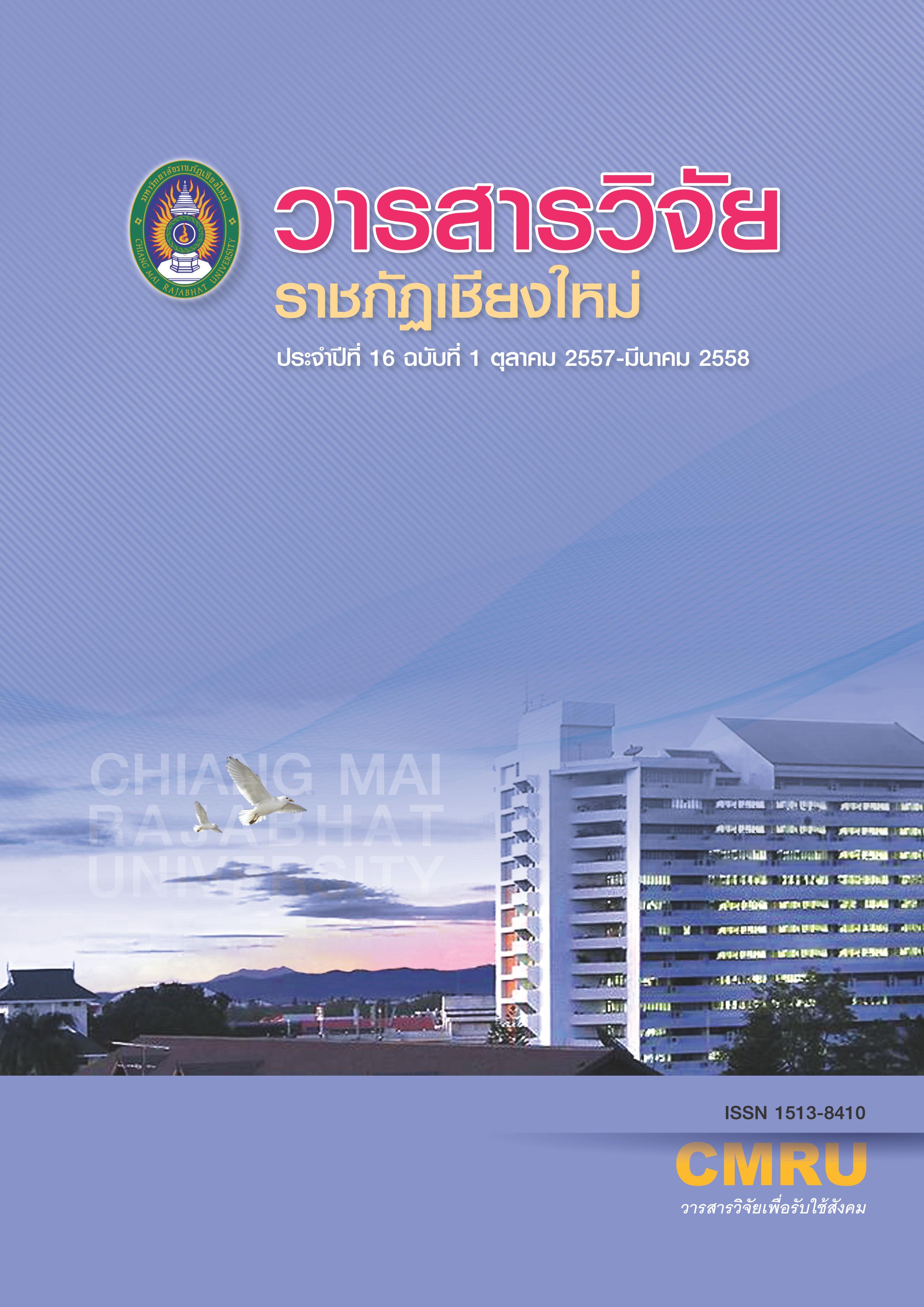การสร้างเครือข่ายสุขภาพเพื่อการพึ่งตนเองในการป้องกันและควบคุมโรคไข้เลือดออก ของโรงพยาบาลส่งเสริมสุขภาพตำบลบ้านซาง อำเภอแม่ริม จังหวัดเชียงใหม่
DOI:
https://doi.org/10.14456/rcmrj.2015.215091คำสำคัญ:
เครือข่ายสุขภาพ, การพึ่งตนเอง, โรคไข้เลือดออกบทคัดย่อ
การวิจัยนี้มีวัตถุประสงค์เพื่อ 1) เพื่อศึกษาบริบทชุมชนและพฤติกรรมการป้องกันและควบคุมโรคไข้เลือดออกของประชาชนในพื้นที่รับผิดชอบโรงพยาบาลส่งเสริมสุขภาพตำบลบ้านซาง 2) เพื่อสร้างเครือข่ายสุขภาพเพื่อการพึ่งตนเองในการป้องกันและควบคุมโรคไข้เลือดออกของโรงพยาบาลส่งเสริมสุขภาพตำบลบ้านซาง 3) เพื่อสร้างแนวทางการดำเนินกิจกรรมเครือข่ายสุขภาพเพื่อการพึ่งตนเองในการป้องกันและควบคุมโรคไข้เลือดออกของโรงพยาบาลส่งเสริมสุขภาพตำบลบ้านซาง รูปแบบวิจัยใช้การวิจัยแบบผสานวิธีทั้งการวิจัยเชิงคุณภาพและเชิงปริมาณ พื้นที่การวิจัย 3 หมู่บ้าน ได้แก่ บ้านห้วยน้ำริน บ้านซาง และบ้านต้นขาม อำเภอแม่ริม จังหวัดเชียงใหม่ กลุ่มตัวอย่าง คือ เจ้าหน้าที่สาธารณสุข จำนวน 4 คน อาสาสมัครสาธารณสุขประจำหมู่บ้าน จำนวน 30 คน และประชาชนที่อยู่ในความรับผิดชอบของโรงพยาบาลส่งเสริมสุขภาพตำบลบ้านซาง 64 คน รวมทั้งสิ้น จำนวน 98 คน เครื่องมือที่ใช้ในการวิจัยมี 4 ชนิด ได้แก่ แบบสัมภาษณ์เชิงลึก แบบสังเกตแบบมีส่วนร่วม แบบสอบถาม และแนวทางการสนทนากลุ่ม ข้อมูลเชิงคุณภาพ ใช้การเขียนบรรยายเชิงพรรณนา ข้อมูลเชิงปริมาณใช้สถิติพรรณนา คือ ค่าร้อยละ และส่วนเบี่ยงเบนมาตรฐาน ผลการวิจัยพบว่า
1. ชุมชนพื้นที่วิจัยทั้ง 3 แห่ง มีการระบาดของโรคไข้เลือดออกสูงเป็นอันดับที่ 3 ของจังหวัดเชียงใหม่ และมีพื้นที่ระบาดระดับ A คือ มีผู้ป่วยติดต่อกันเกินกว่า 4 สัปดาห์ใน 3 หมู่บ้าน ซึ่งหมายถึง กระบวนการควบคุมการระบาดของโรคที่ดำเนินการอยู่นั้นไม่ได้ผล หรือยังไม่เข้มแข็งพอ
2. การสร้างเครือข่ายสุขภาพพอเพียงเพื่อการพึ่งตนเอง มี 3 ระยะ คือ ระยะการวางแผนและวินิจฉัย ระยะดำเนินกิจกรรมเครือข่าย และระยะสรุปและประเมินผลเครือข่าย มีกิจกรรมทั้งหมด 8 กิจกรรม ได้แก่ การเตรียมชุมชน การวิเคราะห์สถานการณ์และกำหนดปัญหา การพัฒนาศักยภาพแกนนำ การกำหนดกิจกรรมเครือข่าย การประเมินสถานการณ์โรคและพฤติกรรมการป้องกันและควบคุม การสะท้อนคิดและนำเสนอข้อมูล การสร้างเครือข่ายสุขภาพเพื่อการพึ่งตนเอง การหาความตรงและสะท้อนคิด
3. แนวทางการดำเนินกิจกรรมเครือข่ายสุขภาพเพื่อการพึ่งตนเอง ประกอบด้วย 7 องค์ประกอบ ได้แก่ การรับรู้ร่วมกัน การมีวิสัยทัศน์ร่วมกัน การเกิดผลประโยชน์และความสนใจร่วมกัน การมีส่วนร่วม การเสริมสร้างซึ่งกันและกัน การพึ่งพิงกัน และการแลกเปลี่ยนซึ่งกันและกัน
Downloads
เอกสารอ้างอิง
กุนนิดา ยารวง. 2555. การศึกษาปัจจัยที่มีผลต่อพฤติกรรมการป้องกันและควบคุมโรคไข้เลือดออกของประชาชนในตำบลแม่สาย อำเภอแม่สาย จังหวัดเชียงราย. การค้นคว้าแบบอิสระ สาธารณสุขศาสตรมหาบัณฑิต มหาวิทยาลัยพะเยา.
เกรียงศักดิ์ เจริญวงศ์ศักดิ์. 2543. การจัดการเครือข่าย: กลยุทธ์สำคัญสู่ความสำเร็จของการปฏิรูปการศึกษา. กรุงเทพฯ: ซัคเซส มีเดีย.
ยุทธพงศ์ ภามาส. 2553. การสร้างพลังประชาชนในการป้องกันโรคไข้เลือดออก อำเภอดอนจาน จังหวัดกาฬสินธุ์. งานนิพนธ์ สาธารณสุขศาสตรมหาบัณฑิต มหาวิทยาบูรพา.
สำนักโรคติดต่อนำโดยแมลง. 2554. สถานการณ์โรคไข้เลือดออกในประเทศไทย ปี 2553. (ระบบออนไลน์). แหล่งที่มา http://www.thaivbd.org/dengue.php?id=93. (13 มีนาคม 2554)
อุษาวดี ถาวระ. 2544. ยุงลายพาหะโรคไข้เลือดออก และไข้ชิคุนกุนยา. ใน อุษาวดี ถาวระ (บรรณาธิการ), ชีววิทยา นิเวศวิทยา และการควบคุมยุงในประเทศไทย. กรุงเทพฯ: สถาบันวิจัยวิทยาศาสตร์สาธารณสุข กรมวิทยาศาสตร์การแพทย์ กระทรวงสาธารณสุข.
Polit, D. F., & Beck, C. T. 2012. Nursing Research: Generating and assessing evidence for nursing practice. (9th ed). Philadelphia: PA: Lippincott Williams & Wilkins.
Yamane, T. 1973. Statistics: An Introductory Analysis. Third editio. Newyork: Harper and Row Publication.
ดาวน์โหลด
เผยแพร่แล้ว
รูปแบบการอ้างอิง
ฉบับ
ประเภทบทความ
สัญญาอนุญาต
1. บทความ ข้อมูล เนื้อหา รูปภาพ ฯลฯ ที่ได้รับการตีพิมพ์ใน “Community and Social Development Journal” ถือเป็นลิขสิทธิ์ของ Community and Social Development Journal มหาวิทยาลัยราชภัฏเชียงใหม่ และเพื่อให้เผยแพร่บทความได้อย่างเหมาะสมผ่านสื่อสิ่งพิมพ์และอิเล็กทรอนิกส์ ผู้เขียนยังคงถือครองลิขสิทธิ์บทความที่ตีพิมพ์ภายใต้ใบอนุญาต Creative Commons Attribution (CC BY) ซึ่งอนุญาตให้เผยแพร่บทความซ้ำในแหล่งอื่นได้ โดยอ้างอิงต้องอ้งอิงบทความในวารสาร ผู้เขียนต้องรับผิดชอบในการขออนุญาตผลิตซ้ำเนื้อหาที่มีลิขสิทธิ์จากแหล่งอื่น
2. เนื้อหาบทความที่ปรากฏในวารสารเป็นความรับผิดชอบของผู้เขียนบทความโดยตรง ซึ่งกองบรรณาธิการวารสารไม่จำเป็นต้องเห็นด้วยหรือร่วมรับผิดชอบใดๆ














